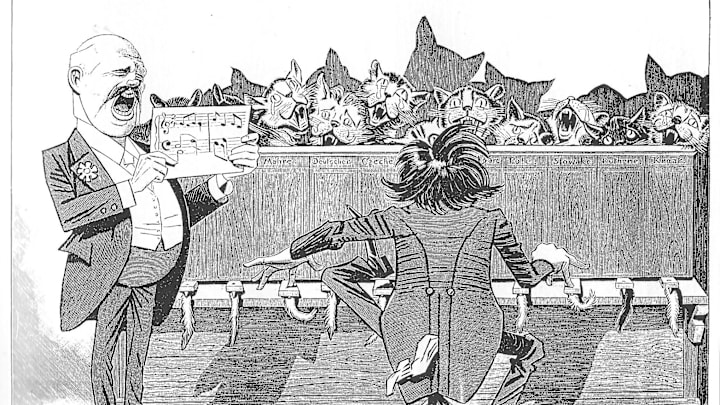Long before the wonders of keyboard cat, felines and music had a tense relationship. The two were tied by an infernal instrument—the katzenklavier, or cat organ.
Imagine a row of eight cats tightly packed in individual cages, wedged along a keyboard. Their tails are pinned down and pulled taut. With the touch of a key, a mechanism slams a nail down into the cat’s tail. So when a keyboardist plays a tune, the cats—which are arranged according to the pitches of their meows—yowl together in pain, crying out in musical harmony.
IMPURRFECT ORIGINS
Historians aren’t sure when the cruel kitty keyboard was invented. Many credit Athanasius Kircher with the original design. A German Jesuit scholar, Kircher wrote about the instrument in 1650, saying it was made for a mopey monarch:
"In order to raise the spirits of an Italian prince burdened by the cares of his position, a musician created for him a cat piano. The musician selected cats whose natural voices were at different pitches and arranged them in cages side by side, so that when a key on the piano was depressed, a mechanism drove a sharp spike in the appropriate cat’s tail. The result was a melody of meows that became more vigorous as the cats became more desperate. Who could help but laugh at such music? Thus the prince was raised from his melancholy."
If true, this wasn’t Kircher’s only fling with animal-made music. He was good friends with Gaspar Schott, a Jesuit who allegedly once tried assembling a chorus of donkeys.
Kircher was a scientific superstar, too. He invented the Aeolian harp and the magnetic clock—and was one of the first people to propose that germs caused the bubonic plague. But contrary to common lore, he probably didn’t invent the cat organ. Accounts of the instrument existed before Kircher was born. In the 16th century, historian Juan Calvete de Estrella described seeing one when King Phillip II processed into Brussels. The parade was rowdy, and it included a cat organ played by a chariot-riding bear.
Yes. A bear.
French writer Jean-Baptiste Weckerline described the scene:
"The most curious was on a chariot that carried the most singular music that can be imagined. It held a bear that played the organ; instead of pipes, there were sixteen cat heads each with its body confined; the tails were sticking out and were held to be played as the strings on a piano ... the corresponding tail would be pulled hard, and it would produce each time a lamentable meow"
FOR SCIENCE!
In 1803, German psychiatrist Johann Christian Reil (who coined the word “psychiatry”) trumpeted the katzenklavier’s medical potential. Reil suggested the cat organ could help chronic daydreamers snap back to reality. He said that a “fugue played on this instrument—when the ill person is so placed that he cannot miss the expression on their faces and the play of these animals—must bring Lot’s wife herself from her fixed state into conscious awareness.”
Basically, Reil believed the katzenklavier was the only thing crazy enough to grab the attention of crazy people.
Despite all these historical records, scholars are unsure whether anyone ever built a katzenklavier for real. It was likely just a hypothetical instrument. (It would have made terrible music anyway. Cats don’t meow on a fixed pitch.)
We are sure, however, of the existence of the katzenklavier’s cousin: the pig organ. In the 15th century, King Louis XI of France ordered Abbot de Beigne to create a “concert of swine’s voices.” Obliging, the abbot built a crude keyboard made of live pigs, which jabbed spikes into the rumps of squealing swine. A similar instrument—the porko-forte—was designed in Cincinnati 400 years later.
As for the cat organ, if you want to hear a humane model, listen to Henry Dagg’s rendition of “Over the Rainbow.” In 2010, the sound sculptor crafted a modern katzenklavier from 16 kitty squeaky toys.
This piece originally ran in 2013.
